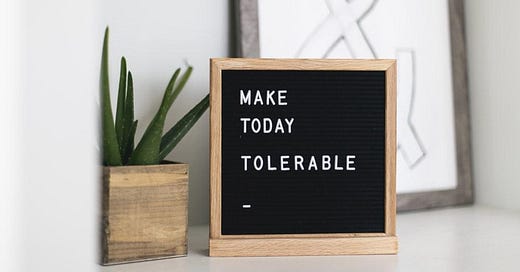How to Beat Burnout
Relieve Stress Without Quitting Your Job, Meditating for 4 Hours a Day, or Drinking Even More Coffee
Programming Note: We’re launching a 5-day “Beat Back Burnout” challenge starting on Monday. Come and join us! (Or see details below.)
Raise your hand if you feel a bit stressed and overwhelmed right now. ✋
Yeah, me too. Work is demanding. Life is hectic. The news is… well, the news. And somehow, you’re expected to juggle it all, stay productive, and still have the energy to enjoy life.
But what happens when the stress starts coming and it don’t stop coming, fed to the rules and you hit the ground running? (Hey now, you’re an all star, get your game on, go play!)
If you’re like most people, you probably experience that creeping sense of burnout—where every task feels heavier, focus is harder to find, and even small things start to feel overwhelming.
And what advice do you usually hear?
Take a break! (Sure, and come back to an even bigger pile of work?)
Try this productivity hack! (Because what you really need is to wake up at 4:30 a.m. and drink celery juice?)
Just push through! (That’s how you got here in the first place.)
Here’s the truth: High-performing professionals—the ones who stay sharp, engaged, and actually enjoy their work—don’t avoid stress. They transform how they handle it.
And they do it without stepping back, ignoring the world around them, or sacrificing their careers.
The Secret: Cognitive Interrupts
Instead of letting stress run on autopilot, top performers use Cognitive Interrupts—small, strategic mental shifts that help rewire the brain’s response to stress in real time.
Think of it this way:
Your brain has default settings when it comes to stress. It’s different for everyone, but generally, when the pressure hits, it follows a predictable pattern—overthinking, tension, procrastination, frustration, exhaustion, or snapping a pen in half because you couldn’t get the cap off and that seemed like the most logical solution at the time (side note: anyone know how to get blue ink out of your shirt? Asking for a friend…).
You’ve probably felt that stress cycle before:
That moment when your inbox feels like a never-ending avalanche.
The fear of going on social media because you might read a post that triggers a near-meltdown.
The spiral of thinking I should be working → I can’t focus → Now I feel even worse.
Cognitive Interrupts break that cycle.
Instead of reacting with stress, your brain learns to shift gears in the moment. These small, intentional disruptions:
✅ Break mental autopilot—so stress doesn’t automatically take over your day.
✅ Create mental space—so you stay engaged and find solutions instead of spiraling.
✅ Make work feel lighter—so even tough tasks don’t feel as draining.
You’re probably already using micro Cognitive Interrupts without realizing it.
Ever found yourself:
Taking a deep breath before responding to an annoying email?
Walking away from your desk and coming back with fresh ideas?
Laughing at a ridiculous meme then realizing work already feels a tad less heavy?
Those are Cognitive Interrupts, even if you didn’t realize what you were doing. They served as quick resets in between trigger and reaction.
Now imagine using them intentionally, in a structured way that’s repeatable—so stress never hijacks your productivity, your energy, or your sanity again.
How This Works in Real Life
If you’re constantly feeling stressed, overwhelmed, or drained by work, the solution isn’t to quit, disappear to a remote island, or just hope things get better on their own.
Instead, it’s about taking control of how you respond to stress.
That starts with a simple three-step process:
1️⃣ Reframe your relationship with stress. Stress isn’t the enemy—it’s information. The first step is understanding what’s actually causing your stress. You can’t solve a problem you haven’t defined.
2️⃣ Solve the immediate stressors. Once you’ve identified your biggest stress triggers, you need a strategy for handling them (like I wrote about a few weeks ago: four ways to manage stress). This could mean setting boundaries, changing how you approach tasks, or using specific Cognitive Interrupts to break stress patterns as they happen.
3️⃣ Build long-term habits and rituals. Because stress isn’t going away anytime soon. The key to long-term sanity is developing daily routines and mental habits that keep stress from piling up in the first place.
You Don’t Have to Do This Alone
Burnout thrives in isolation.
One of the biggest challenges of feeling overwhelmed is that it can make you believe you’re the only one struggling. But the truth is, so many people are experiencing the same thing right now.
That’s why one of the best things you can do—beyond learning new strategies—is to surround yourself with people who get it. People who know what it’s like to balance ambitious goals with real-life pressures.
Because when you’re around like-minded professionals who are actively working through stress instead of being consumed by it, something powerful happens:
💡 You realize you’re not alone.
💡 You gain new perspectives that help you navigate stress differently.
💡 You learn proven strategies that are actually working for other people.
And instead of feeling stuck, you start making real progress.
Join the 5-Day Beat Back Burnout Challenge
If this resonates with you, I’ve got something coming up you’ll want to be a part of:
🚀 Next Monday, I’m kicking off a free 5-Day Beat Back Burnout Challenge.
Each day, you’ll get simple but powerful techniques to:
✔️ Shift your mindset around stress
✔️ Handle work challenges without feeling drained
✔️ Create habits that make burnout a thing of the past
It all starts with a live virtual kickoff where you’ll learn how to reframe stress and unlock the power of Cognitive Interrupts. Then we’ll be sharing daily challenges for combating burnout (and sharing a boatload of funny content to help you through it).
Ready to beat back burnout? Join the challenge.
(an)drew
Silly Joke at the End: Some say stress relief is a matter of laugh or death.









That’s a great- fun joke ill pass Around